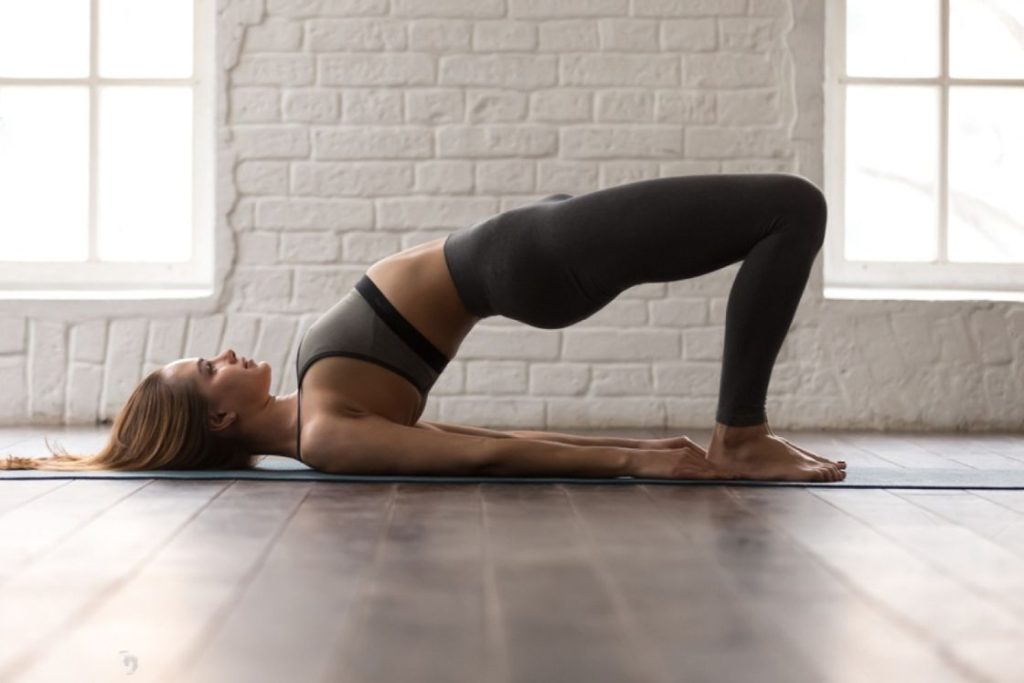
Cervical spondylosis is a chronic neck pain associated mainly with aging. However, changing modern lifestyles and sitting at a desk for hours contribute to the occurrence of cervical spondylosis even in the young population.
More and more people are complaining of neck pain caused either by working at a desk or by the natural age-related wear and tear of the disks in the neck. It is a common problem that worsens with age.
The problem of cervical spondylosis is often treated with medications and other non-surgical treatments. On the other hand, one of the natural and holistic methods to prevent and relieve the symptoms of cervical spondylosis is yoga therapy.
Yoga relieves neck pain by gently stretching and relaxing the muscles in the neck. It also improves the flexibility of these muscles, relieving pain and building strength. Practicing yoga exercises also leads to more energy and therefore better productivity.
Let’s look at the basic details of cervical spondylosis and how it can be relieved through yoga.
What is Cervical Spondylosis?
Cervical spondylosis is characterized by wear of the bones and cartilage of the cervical spine. Seven vertebrae beginning at the base of the skull form the cervical spine.
Over time, the cartilage deteriorates, bone spurs can form as the bones rub against each other where there is no cartilage, the disks (jelly-filled soft donuts between each vertebra) can dry out and break, and the ligaments can swell. For this reason, it is sometimes called neck arthritis or arthritis.
The development of cervical spondylosis does not necessarily lead to disability. The degeneration of the bones causes constant pain in the neck and often stiffness. But the chronic pain that occurs with this condition can interfere with the patient’s daily functioning and can also lead to weakness in the neck, arms and even legs.
Cervical spondylosis is considered a common phenomenon of age-related health problems, where the spine begins to wear out around the age of 30.
Causes of Cervical Spondylosis
As mentioned above, the general causes of cervical spondylosis are excessive degeneration of the bones, cartilage, and ligaments, and the development of bone spurs in the cervical spine. Herniated disk, in which the disk ruptures or tears due to age, is also an important cause.
Progressive osteoarthritis can also drive the growth process of cervical spondylosis faster than the normal aging process.
Some other causes or risk factors of cervical spondylosis are:
- Smoking or prior history of smoking
- Occupational strain in the neck due to incorrect posture
- Family history
- Neck injury
- Heavy lifting
- Exposure to extreme vibrations or irregular jerk of the neck
Symptoms of Cervical Spondylosis
In most cases, people with cervical spondylosis do not experience the usual symptoms. However, the most common symptoms that should not be overlooked are:
- Stiffness and pain in the neck. This is one of the main symptoms and can worsen when the neck is moved.
- Headache and dizziness.
- Clicking, popping or grinding sounds when moving the neck.
- Muscle cramps and soreness.
Occasionally, due to cervical spondylosis, there may be shrinkage of the spinal canal within the vertebrae. The spinal canal is the area between the vertebrae through which the spinal cord and nerve roots travel to the rest of the body. The following symptoms may occur when the spinal cord or nerve roots are pinched:
- Arms, hands, legs or feet that are tingling, numb or weak
- Difficulty walking and lack of coordination
- Lack of bowel or bladder control
How is Yoga Effective for Cervical Spondylosis
Yoga therapy is a holistic treatment method that is useful in treating the symptoms of chronic neck pain. When you perform low-impact yoga asanas, you promote stretching and strengthening of the neck muscles. Some yoga postures also promote better posture, which directly affects the condition of the neck.
If you start yoga at a young age, muscles will be stimulated regularly and bones, muscles, ligaments and cartilage will be well taken care of. Yoga for cervical spondylosis relieves stiffness and pain while improving mobility if you already have mild symptoms.
Over the years, several research studies have been conducted to investigate the effectiveness of yoga in treating cervical spondylosis.
Scientific Study
A 2016 study found that yoga interventions such as breathing, postures, and relaxation lead to stretching and strengthening of the cervical, scapulo-thoracic areas of the neck and provide effective relief of pain in the neck and shoulders.
Another research published in February 2019 concluded that yoga is good for relieving the intensity of pain and improving pain-related function disability. It also suggested that yogic methods resulted in improved quality of life and mood in patients with chronic neck pain.
A 2015 study figured that yoga and especially relaxation techniques are advantageous for relieving the stiffness of the neck and shoulders.
A systematic study of literature in the same year concluded that Iyengar yoga was extremely effective in treating spinal neck as well as back pain. Similarly, techniques from simplified Kundalini Yoga have been shown to work in the majority of cervical spondylosis cases in a 2018 study.
A June 2020 research demonstrated the clinical effect of yoga in treating cervical spondylosis. Its results stated that yoga is more influential in maintaining the efficacy of the patient and inhibiting the recurrence of the symptoms.
Though the clinical trials for the effectiveness of yoga therapy on cervical spondylosis are still in their infancy, the above-published work provides sufficient evidence that it can be used as an alternative method of treatment.
Yoga Practices for Cervical Spondylosis
The below-mentioned yoga practices can help cervical spondylosis patients by reducing pain, and stiffness, and increasing their day-to-day productivity.
Yoga Poses Cervical Spondylosis
While performing poses, you should make sure that the poses are not being performed in a haste. Avoid any no-jerking movements or excessive forward fold of the neck. Avoid any headstands, shoulder stands, or any balancing inversions as they put significant pressure on the neck.
Moreover, if the condition is severe, you should first check in with a doctor before starting a yoga practice.
Keeping the above in mind, have a look at some yoga poses for cervical spondylosis.
Cobra Pose (Bhujangasana)
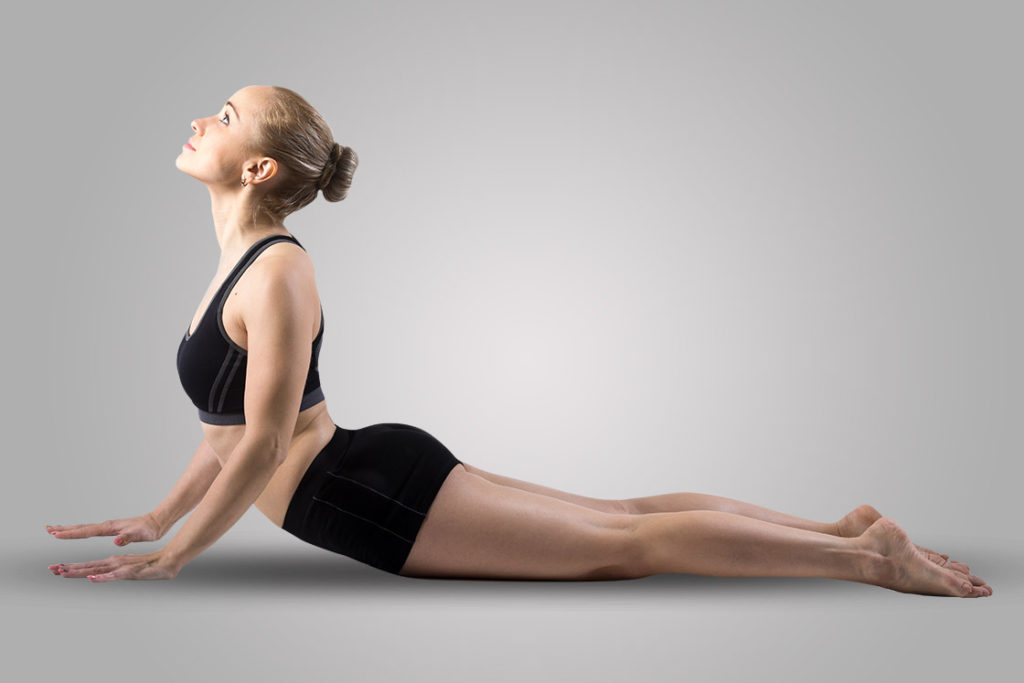
Cobra pose is very useful for neck and spinal problems. The cobra posture eases neck, spine, and shoulder stiffness, which lessens the intensity of cervical spondylosis discomfort. It also improves posture and lengthens the spine.
It can also be practiced with its variations. Patients who have difficulty rising from the abdomen can only lift the part until the chest and look in the front.
Steps to perform
- Lie down on your stomach and place your forearms placed beside your ribs.
- Keep your legs hip-width apart or joined together. The top of your feet should be flat on the yoga mat.
- Place your palms below your shoulders and spread your fingers to create firm support. Your elbows should be close to the torso and parallel to each other.
- Putting pressure on your hands and lifting your head and your chest upwards.
- Your lower body, from the pelvis to the toes will stay on the mat. Tilt your head back and gaze upwards.
- Keep your shoulder away from your ears and shoulder blades pressed towards the back.
- Stay in this pose for 3-5 breaths and gently come back to rest your body on the mat.
Bow Pose (Dhanurasana)
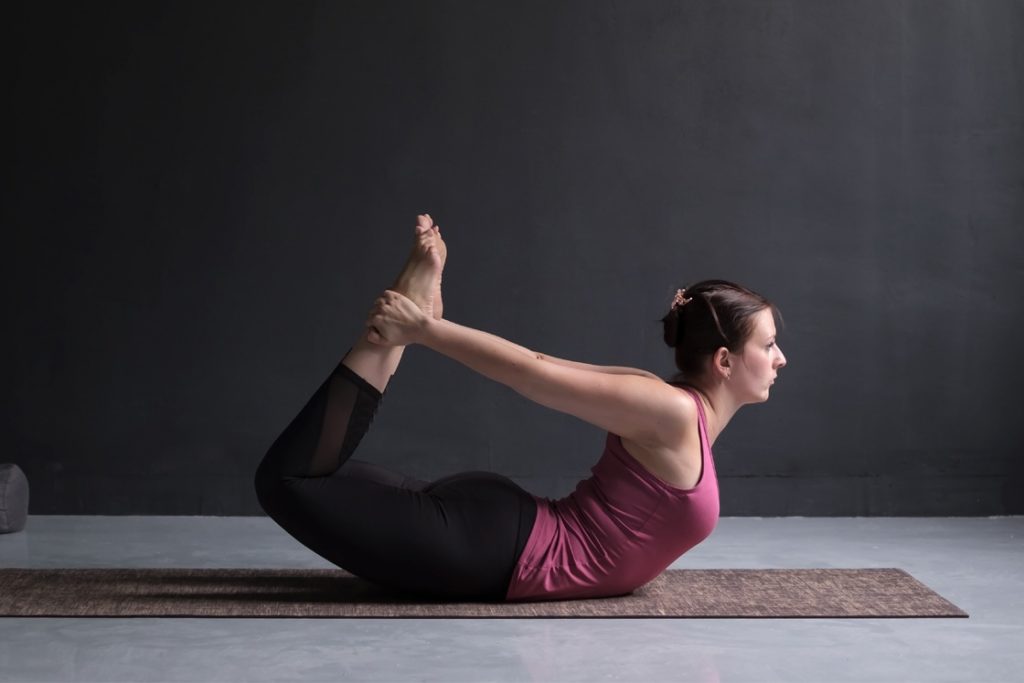
Dhanurasana or bow pose is beneficial for stretching your spine and opening up your shoulder blades. It enhances the flexibility of the spine, thereby reducing any stress in the region. To prevent hunched shoulders, the bow pose expands and strengthens the shoulders from the front. The arms can be stretched and the spine can be strengthened. The position of the head also effectively massages the neck.
Please note that releasing the bow pose should be done very gently, especially by patients with cervical spondylosis.
Steps to perform
- Lie on your stomach with your arms by your side. Spread your legs hip-width apart.
- Bend your knees to bring your heels as close to the buttocks as possible keeping your toes pointed upwards.
- Wrap your hands around your ankles and hold them firmly. Do not hold the top of the feet as your hands might slip. You can also use a strap if your shoulders are stiff.
- Gently start lifting your feet towards the ceiling. As you lift, your head, torso, and thighs should also lift upwards.
- Lift till only your core and pelvis are touching the mat while the rest of the body is pointing upwards.
- Keep your focus on the front. After a few minutes, you can also tilt your head slightly upwards.
- Hold the pose for 3-5 breaths. Release the pose gently to avoid sudden strain.
Sitting Half Spinal Twist (Ardha-Matsyendriasana)
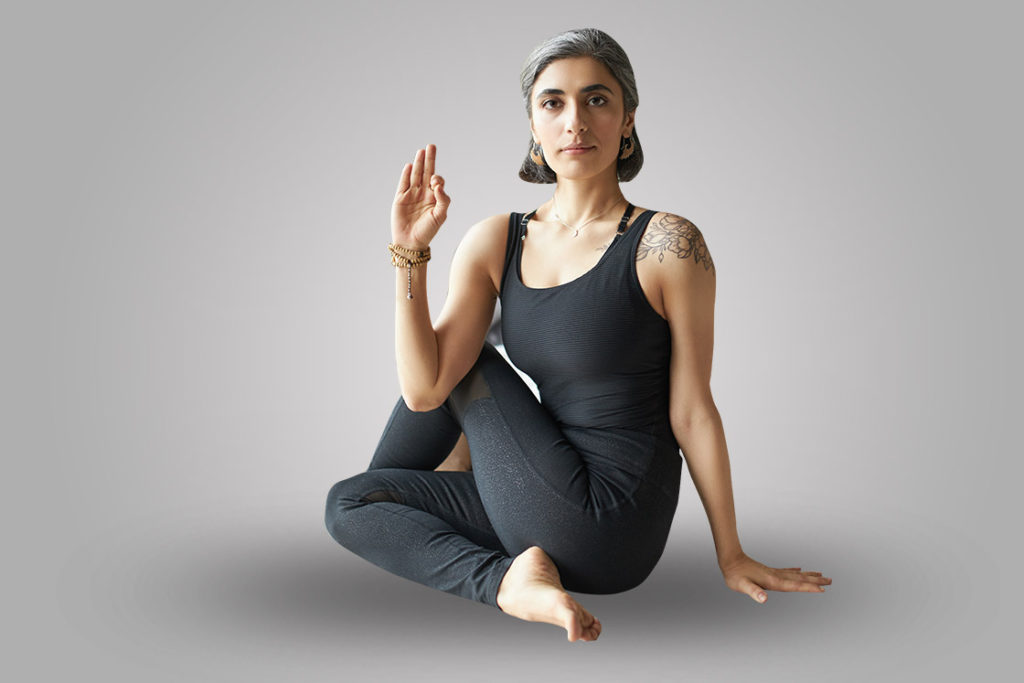
The sitting half spinal twist or ardha-matsyendriasana provides flexibility to the neck and spine muscles and enhances their strength. It is a sitting posture that contributes to the elasticity of the spine and hence is good to relieve tension around neck muscles.
Steps to perform
- Sit in Dandasana (Staff Pose). Bend your right knee, bringing the heel close to the sitting bone.
- Keeping your left leg straight, lift your right foot and bring it over the left thigh. Place the right foot outside the left knee or thigh.
- Bend your left leg so that the heel comes under the right buttock.
- Twist your torso toward the right while simultaneously taking your right arm back and placing your palm behind the hip.
- Bring your left arm to the front and place the elbow on the outside of the right knee. Your left hand will be pointed upwards with your fingers closed.
- Alternatively, you can place the left arm in front of you, with elbows on the bent knee, or wrap your forearm around your right knee.
- Turn your head with the twist and gaze over your shoulders.
- Keep this pose for 5-8 breaths and repeat with the other leg.
Cat/Cow Pose (Marjariasana/Bitilasana)
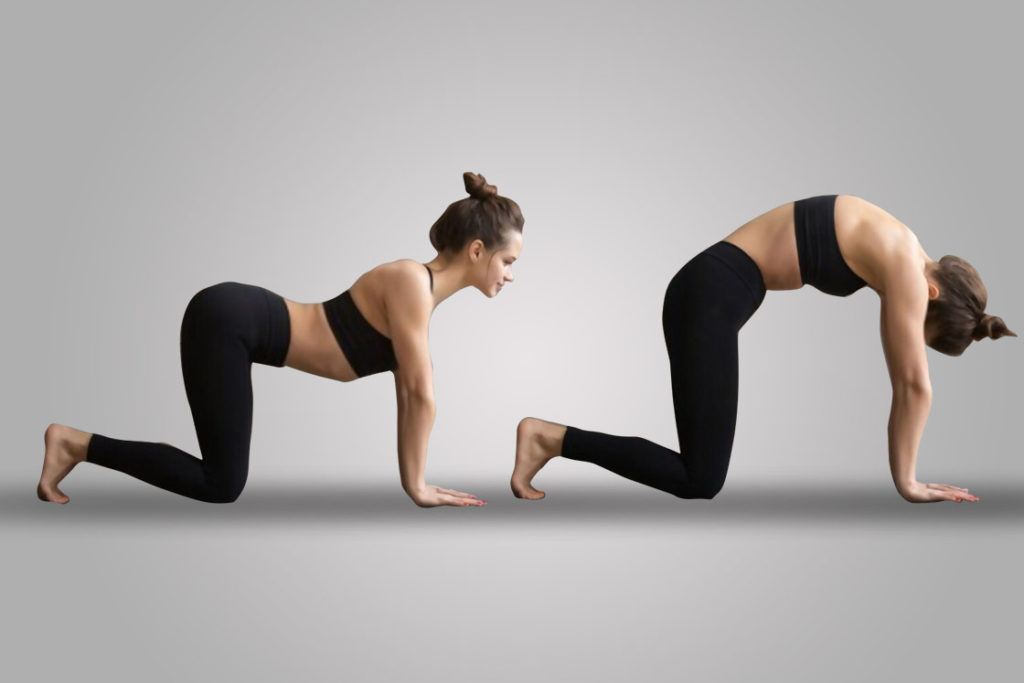
After spending the day seated, this pose is excellent for energizing your spine. Additionally, your head flexes in unison with your spine, which will loosen up some of the tight muscles there and relieve strain. It contributes to improved flexibility by relaxing the muscles around the neck and spine. This pose can benefit patients with cervical spondylosis by strengthening their cervical spine and relieving stress.
Steps to perform
- Get on all fours in the tabletop position. Keep your spine neutral and parallel to the ground.
- Place your palms with fingers spread for even distribution of weight. Spread your legs hip-width apart bringing your ankles in line with your knees.
- Your shoulders and hips should be stacked above your wrists and knees respectively.
- Inhale, and dip your stomach. Push the sitting bones up, drawing the shoulders and chest forward.
- Tilt your head upwards to stretch the front of the neck.
- Exhale while curving your back like a cat, pulling your belly button closer to your spine and your pelvis closer to your rib cage.
- Drop your head to feel a stretch on the back of your neck.
- Perform this movement at least 5-10 times.
Bridge Pose (Setubandhasana)
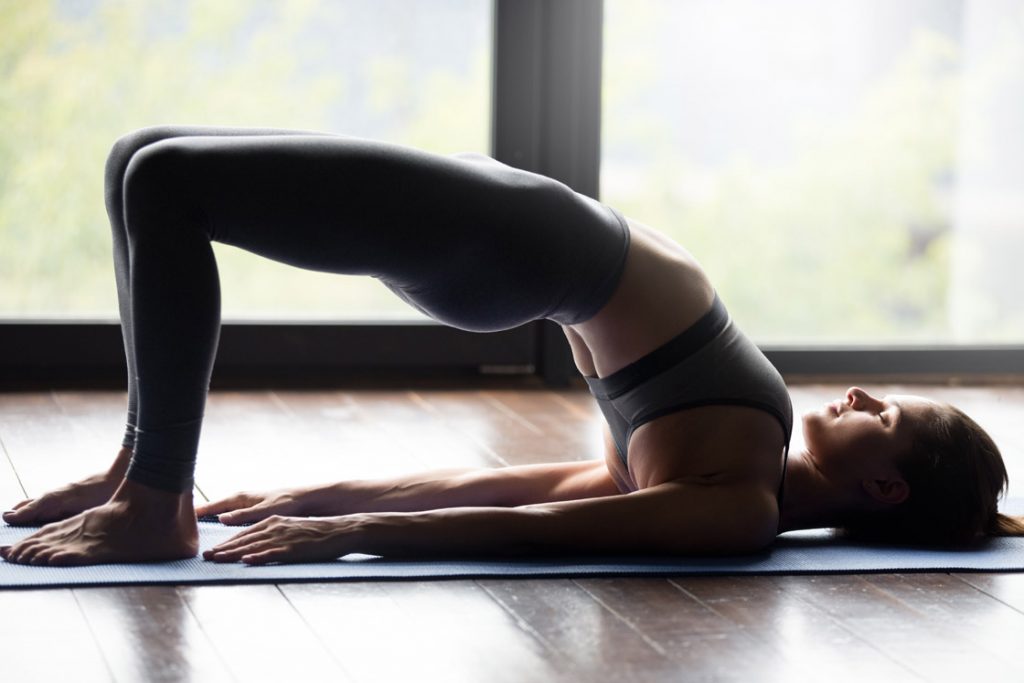
The bridge pose strengthens your back muscles and relieves the tension from the back and neck instantly. It gives a gentle stretch to the neck, improving its functions and relaxing the stress in the neck region. Your chest, neck, and spine are stretched in this impactful stance.
Patients of cervical spondylosis should be careful while lifting the chest as the balance of the upper body is maintained on the neck and the shoulders.
Steps to perform
- Lie down on your mat with your legs bent at the knees. Spread them hip-width apart and press your soles firmly on the mat.
- Your lower legs should be parallel to each other with your knees stacked over your ankles.
- Place your arms beside you, palms facing down.
- Engage your core and placing your feet firmly on the mat, lift your hips off the mat.
- To reduce the pressure on the upper body, you can place a stack of books or yoga blocks under your hips. Additionally, put a folded blanket or towel under your shoulder blades for an enhanced cushion.
- Keep pressing down your feet to lift your thighs, hips, lower back, and upper back.
- Hold this position for 3-5 breaths.
Fish Pose (Matsyasana)
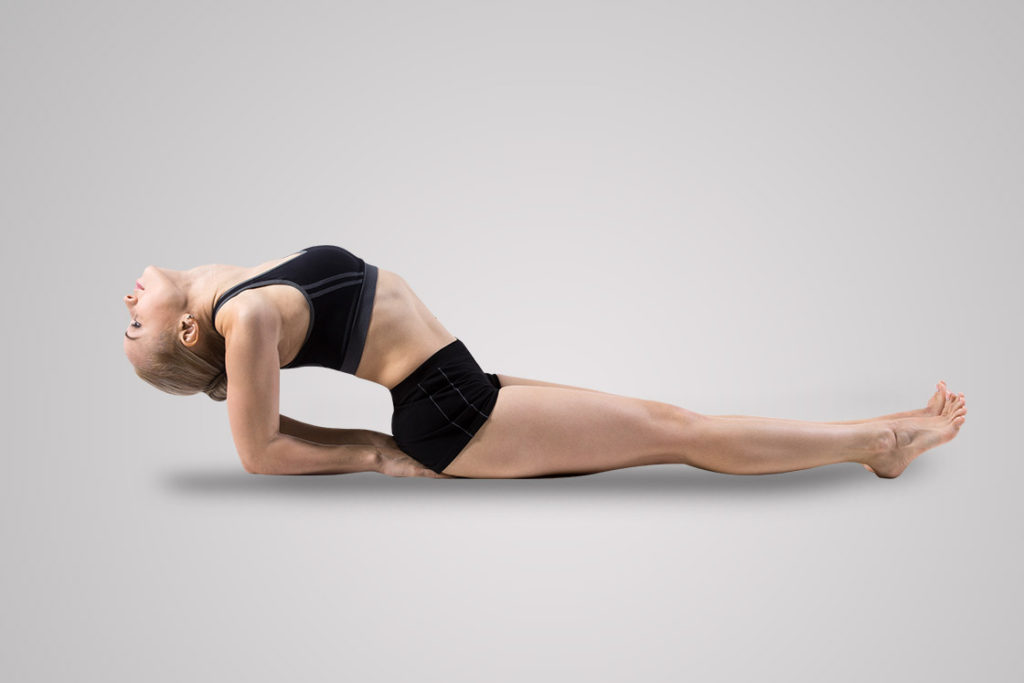
The fish pose or Matsyasana is an excellent practice for stretching the spinal and neck muscles. It relaxes the muscles, thereby relieving the tension around them. The fish pose helps to push back shoulders that are rounded in the front. By making your neck and upper back stronger, it helps to maintain spinal flexibility and good posture.
Steps to perform
- Lie down on your back and keep your legs straight.
- Bend your elbows such that only your forearms are on the ground. Your upper arms will be lifted at an angle. You can also tuck hands under your buttocks for further support.
- Roll your shoulders and keep your shoulder blades firmly against your back to keep your forearms in place.
- Pull up your chest and lift your neck and upper back to give a backbend.
- Tilt your head as far back as your neck muscles allow. If you feel the slightest discomfort, reduce the tilt.
- To stay in this position longer, place a bolster, a stack of folded blankets, or towels under your upper back. You can also keep a folded blanket under your head for an extra cushion.
- Throughout the practice keep your pelvis and legs actively engaged.
- Stay in this pose for 3-5 breaths.
Pranayama and Mudras
Though they might not physically impact the ailment, including pranayama and mudras in your yoga practice can complement your asana practice. They will help you to channel the energy in the right direction and calm your mind for a peaceful practice. It will also boost the healing process.
Anulom-Vilom
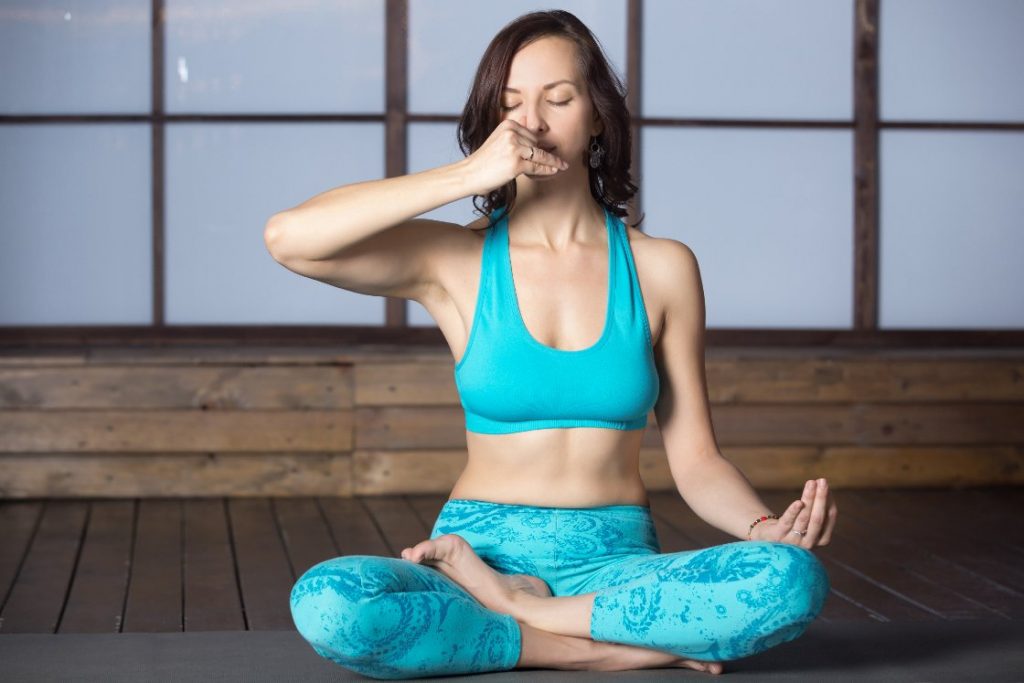
Anulom-Vilom helps in releasing tension in the body and increases focus. Improved blood and oxygen flow throughout the body are encouraged by this controlled, deep, and slow breathing exercise.
To practice this pranayama:
- Sit in any comfortable meditative posture.
- On your right hand, bend the index and middle finger so that the fingertips touch the base of the fingers. The rest of the fingers stay straight.
- On the left hand, you can make a mudra of your choice.
- Use your right-hand thumb to close the right nostril. Breathe in deeply from your left nostril for 3 counts.
- Close the left nostril with the pinky and ring finger and exhale slowly from the right nostril for 6 counts.
- Keeping the right nostril, inhale deeply and then exhale from the left nostril by closing the right nostril. This completes one cycle of anulom vilom.
- Repeat 5-10 rounds.
- Practice this for at least 5 minutes daily for effective results.
The ratio of inhalation to exhalation is 1:2. You can increase the count for inhaling and exhaling with regular practice while maintaining the ratio.
Bhramari Pranayama
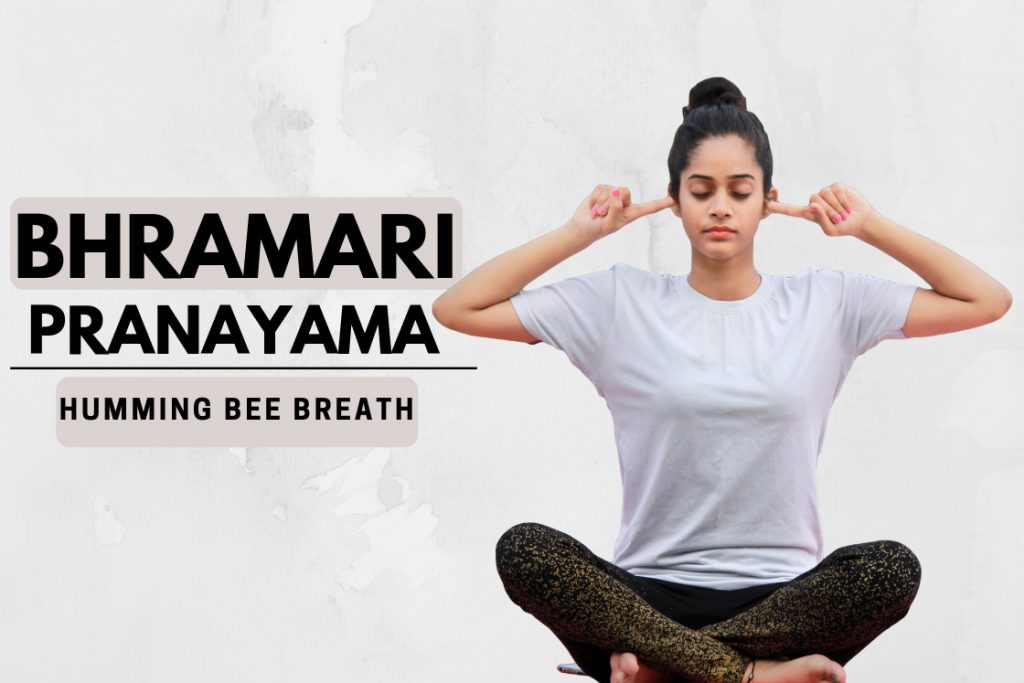
Bhramari pranayama can improve blood pressure, hemoglobin, and liquid in the ears, a decrease of which can cause dizziness. Dizziness is also one of the symptoms of cervical spondylosis, which can be reduced by this pranayama. Problems like headaches can also be alleviated by bhramari pranayama.
Steps to perform
- Sit on a cushioned surface in a meditative position of your choice.
- Keep your back straight and your head aligned with the spine.
- Place your index fingers on the protruding cartilage on the outside of the ear, or tragus, to partially close the ear. The rest of the fingers can be folded inside the palm.
- Inhale through the nose.
- Slightly tuck in your chin (jalandhara bandha), close your ears by pushing the cartilage inwards, and exhale while making a ‘hmmmmm’ sound at the back of your throat.
- Repeat the process 5-7 times.
- After finishing the pranayama, take the time for your breath to return to normal while observing the effects.
Just like pranayama, mudras also help in channelizing the prana through hand gestures. They stimulate the chakras and various energy points in our body to alleviate various symptoms.
Some mudras that you can practice are:
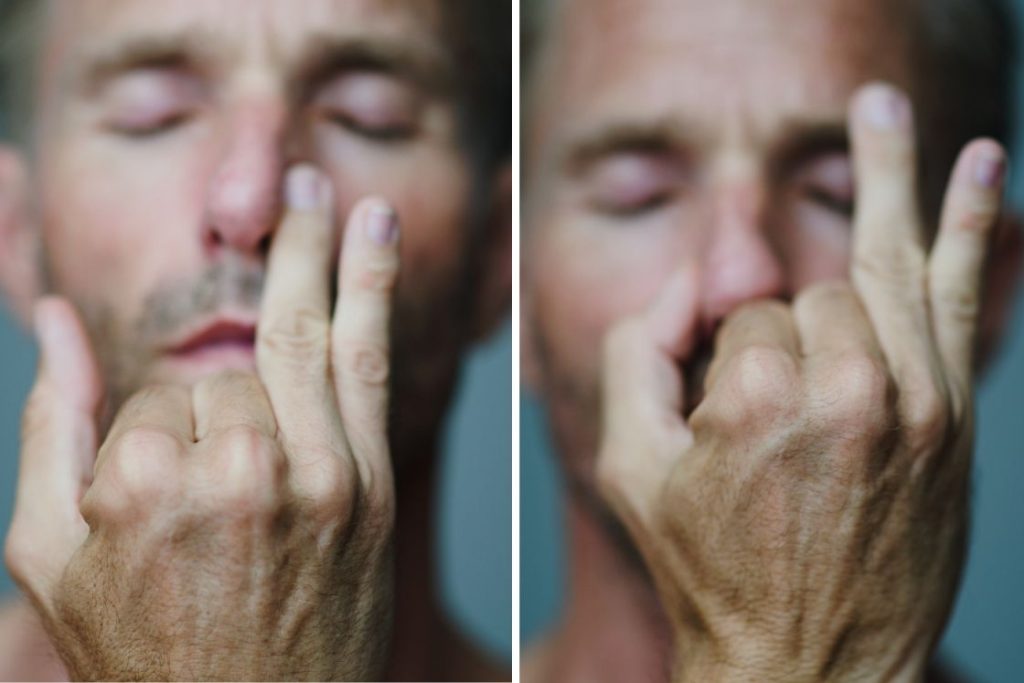
It is the mudra used when practicing anulom-vilom or nadi shodana. This mudra helps in balancing the left and right hemispheres of the brain to bring harmony. Vishnu mudra is made by bending the index and middle finger to touch the base of the thumb while keeping the other fingers extended.
This mudra is generally formed in the right mudra due to its association with the Hindu God Vishnu. The little and ring finger stimulates the svadhisthana and muladhara chakra while the bent fingers represent subdued ego.
It not only helps in relieving stress, keeping a calm mind, aiding in detoxification, and improving focus but can also help manage pain.
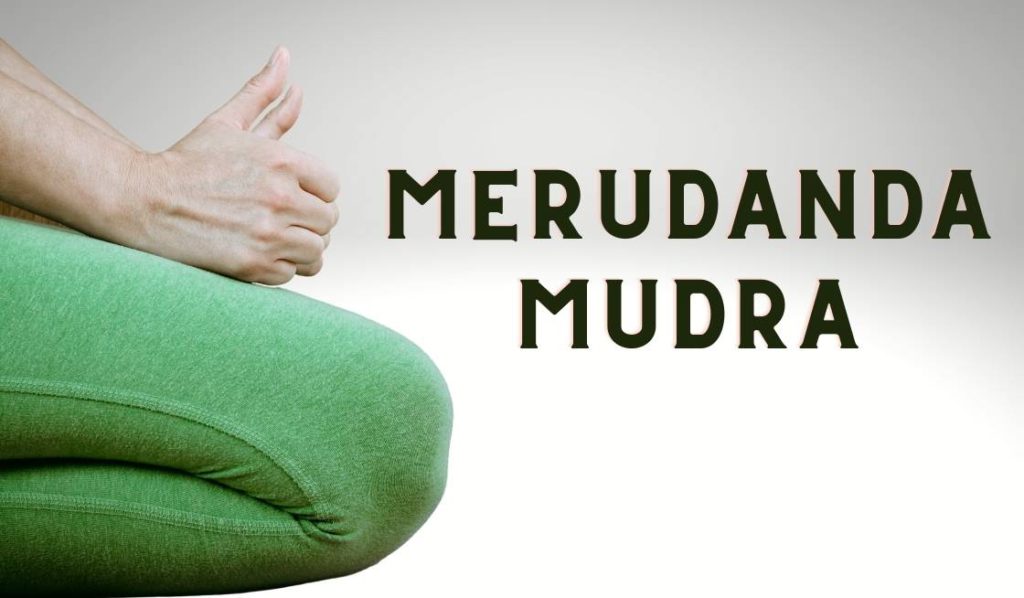
The spinal column is referred to as merudanda in Sanskrit. By massaging the spinal column, it helps pranic energy move more freely throughout the body.
Its calming and healing effects on the spine are the reason it was given that name. The term “Spine Mudra” is also used to describe it.
To practice this mudra, curl your fingers to create a fist but leave your thumb extended. Place your hands on your thighs with the thumb tips pointed towards each other. After 8-10 seconds, turn the fist upwards so that the tips are pointing up and after a few seconds, turn them sideways so that the thumbs are facing outwards.
Remember to practice these yoga poses with awareness and never force any movement that causes pain. If you have severe cervical spondylosis or any other medical condition, it’s essential to consult a healthcare professional or a certified yoga instructor before starting a yoga routine.
Stretching Exercises Cervical Spondylosis
Apart from yoga, various simple and easy neck, head, and shoulder stretches can go a long way to prevent or even reduce mild symptoms of cervical spondylosis. Doing them frequently will remove stiffness and strain which can be beneficial for healing the pain.
Here are a few stretches that you can practice to relieve the pain. These exercises can be done anywhere and anytime while staying seated or standing.
Neck Bends

- Begin by keeping your head in a straight and neutral position.
- While inhaling, bend it to the right and bring it back to the front while exhaling. Repeat the same with the left side.
- Do it around 8-10 times.
- Bring your head to the original position.
- Now as you inhale, bend the neck forward, touching your chin to your chest.
- While exhaling, bring it back to the center.
- Similarly, do this toward the back.
- After repeating 8-10 times.
Neck Rotation
- Keep your straight and aligned with the spine.
- Bend your neck forward and start rotating it slowly from the left side and rotate it for one full circle.
- When you complete one cycle, start the rotation from the right side.
- Make slow movements as rushing in this exercise can result in dizziness.
- Repeat 5 rounds clockwise and 5 rounds anti-clockwise.
Chin Tuck
- Keep your head in a neutral position with your chin parallel to the floor.
- Slowly make a double chin by pulling your chin and neck back. To prevent neck cramps or strain, carry out this motion extremely carefully.
- The muscles in the back of your neck ought should feel a tad stretched.
- Maintain a relaxed jaw throughout the procedure.
- After three to five long breaths, return your chin to the beginning position gently.
- You can do this step as many times as you like.
Shoulder Lift and Rotation
- Bring your head to a neutral position.
- Lift your shoulders with slow inhalation.
- Now forcefully exhale and lower them back to the neutral position.
- Practicing this exercise 8-10 times.
- Place your fingers on the shoulders, with the thumb to the front and the remaining fingers on the back.
- Start rotating in a forward motion slowly. Do complete rotations 5 times.
- Now rotate in a backward motion slowly for another 5 times.
Conclusion
Incorporating these gentle yoga postures into your daily routine can greatly assist in the treatment of cervical spondylosis. Regular practice alongside medical treatment improves flexibility, strengthens muscles and promotes relaxation, ultimately contributing to better neck health and overall well-being. Remember to approach exercises mindfully, listening to your body and avoiding any movements that cause discomfort. If you suffer from severe cervical spondylosis or other conditions, be sure to consult a physician or certified yoga instructor for individualized advice and safe practice. Take advantage of the healing potential of yoga and take a proactive step to find relief and comfort on your path to managing cervical spondylosis.
The post Yoga for Cervical Spondylosis: Relieve Neck Pain and Improve Mobility appeared first on Fitsri.